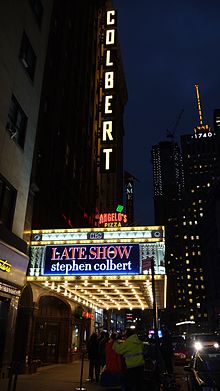Ed Sullivan Theater
| Hammerstein's Theatre Manhattan Theatre Billy Rose's Music Hall CBS Radio Playhouse No. 1 CBS Studio 50 |
|

The Ed Sullivan Theater with The Late Show with Stephen Colbert marquee
|
|
| Address | 1697 Broadway New York City United States |
|---|---|
| Owner | CBS Corporation |
| Type | Television studio (Former Broadway) |
| Capacity | 400 |
| Current use | Television studio |
| Production |
The Ed Sullivan Show (1953–1971) Late Show with David Letterman (1993–2015) The Late Show with Stephen Colbert (2015–present) |
| Construction | |
| Opened | 1927 |
| Closed | 1992 2015 |
| Reopened | 1993 2015 |
| Tenants | |
| The Late Show | |
| Website | |
|
Ed Sullivan Theater
|
|
| Coordinates | 40°45′49.5″N 73°58′58″W / 40.763750°N 73.98278°WCoordinates: 40°45′49.5″N 73°58′58″W / 40.763750°N 73.98278°W |
| Architect | Herbert J. Krapp |
| Architectural style | Neo-Gothic |
| NRHP Reference # | 97001303 |
| Added to NRHP | November 17, 1997 |
The Ed Sullivan Theater (alternatively, CBS Studio 50), located at 1697–1699 Broadway between West 53rd and West 54th, in the Theater District in Manhattan, is a venerable radio and television studio in New York City. The theater has been used as a venue for live and taped CBS broadcasts since 1936.
It is historically known as the home of The Ed Sullivan Show and the site of The Beatles' US debut performance. It has also housed David Letterman's tenure of CBS' Late Show from 1993 to 2015. The theatre currently houses The Late Show with Stephen Colbert, the second incarnation of the Late Show franchise. It is on the National Register of Historic Places, and the interior has been designated a landmark by the New York City Landmarks Preservation Commission.
The 13-story, brown brick and terra cotta office building with a ground-floor theater was designed by architect Herbert J. Krapp. It was built by Arthur Hammerstein between 1925 and 1927, and was named Hammerstein's Theatre after his father, Oscar Hammerstein I. The original neo-Gothic interior contained pointed-arch stained-glass windows with scenes from the elder Hammerstein's operas. Its first production was the three-hour musical Golden Dawn, the second male lead of which was Cary Grant, then still using his birth name, Archie Leach. Arthur Hammerstein went bankrupt in 1931, and lost ownership of the building.
...
Wikipedia

